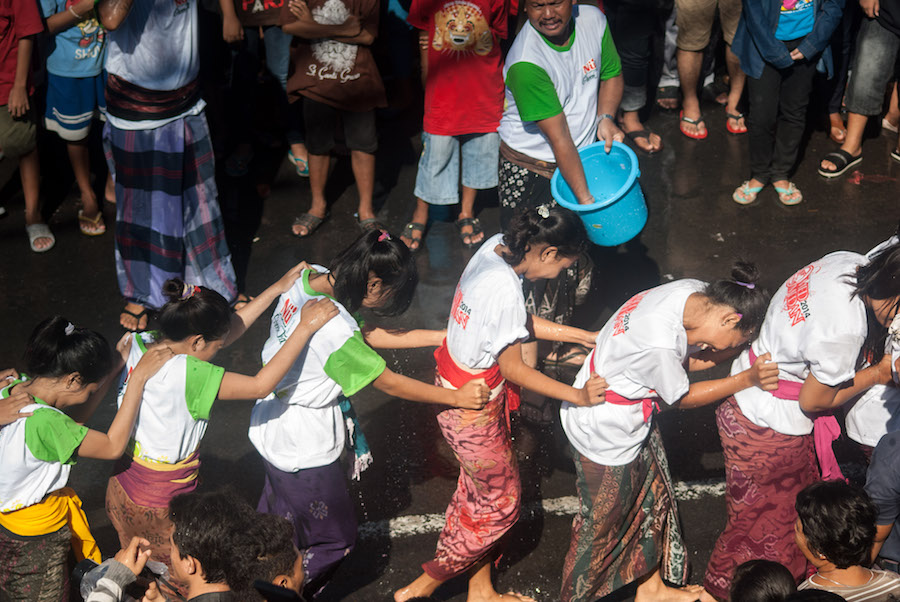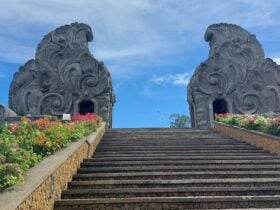Omed-Omedan Balinese Cultural

Omed-Omedan Balinese Cultural. Bali, renowned for its rich cultural heritage, vibrant traditions, and deeply rooted spirituality, is home to countless ceremonies that reflect its unique way of life. Among these, Omed-Omedan, also known as the “Kissing Tradition,” stands out as one of the most intriguing and lively celebrations on the island. Held annually in the village of Banjar Kaja, Sesetan, in Denpasar, this tradition draws locals and visitors alike to witness and participate in an age-old ritual of togetherness, joy, and love.
In this article, we’ll dive into the history, significance, and vibrant atmosphere of Omed-Omedan, shedding light on one of Bali’s most fascinating cultural events.
What is Omed-Omedan?

Omed-Omedan is a traditional Balinese ceremony celebrated on the day after Nyepi, the Balinese Day of Silence. The term “omed-omedan” translates to “pull-pull,” which perfectly describes the nature of the event. During the celebration, young men and women, typically aged between 17 and 30, gather in the village square to engage in a joyful tug-of-war that often ends with participants playfully pulling and kissing each other.
Far from being merely a playful ritual, Omed-Omedan is steeped in cultural and spiritual significance. It is believed to bring blessings, promote harmony, and foster community ties, making it an essential part of the Balinese cultural calendar.
The History of Omed-Omedan

1. Origins in the Banjar Kaja Community
The origins of Omed-Omedan can be traced back to the village of Banjar Kaja, Sesetan, where it has been practiced for generations. Legend has it that the tradition began during the reign of a Balinese king in the 17th century. The king, after witnessing villagers engaging in playful tugging and pulling during a post-Nyepi celebration, recognized its potential to promote unity and declared it a tradition.
2. Symbol of Togetherness
Omed-Omedan has always been about more than just fun. It symbolizes the importance of community, harmony, and the balance of energies after the reflective and silent Nyepi holiday. The event serves as a way for the community to reconnect, cleanse negative energies, and start the new year with renewed unity and joy.
3. Spiritual Significance
According to local beliefs, skipping the Omed-Omedan tradition could invite misfortune to the village. This belief reinforces the ceremony’s importance and ensures its continuation across generations.
How Omed-Omedan is Celebrated

Omed-Omedan is a vibrant and festive event that unfolds with a series of rituals and activities:
1. Preparations
- The ceremony begins with traditional preparations by the villagers. The participants, all unmarried young men and women, are selected to represent the community.
- Offerings are prepared and prayers are conducted at the village temple to seek blessings for a smooth and harmonious event.
2. The Main Event
- The young men and women are divided into two groups: males on one side and females on the other.
- After a brief tug-of-war, participants are encouraged to kiss each other while being pulled toward the opposite group.
- The atmosphere is filled with laughter, cheering, and excitement as villagers and spectators gather to watch the playful interactions.
3. Holy Water Blessings
- Throughout the event, the participants and the crowd are doused with holy water by village elders. This act is believed to purify and bless everyone present.
4. Music and Dancing
- The event often concludes with traditional Balinese music and dancing, creating a festive atmosphere that reflects the joy and unity of the community.
Significance of Omed-Omedan

Omed-Omedan holds deep cultural and spiritual importance for the Balinese people:
- Promotes Unity and Harmony
- The ceremony fosters a sense of togetherness among the villagers and strengthens communal bonds.
- Symbol of Transition
- Held the day after Nyepi, Omed-Omedan serves as a transition from silence and introspection to renewal and celebration.
- Blessings for the Community
- The ritual is believed to bring blessings and good fortune to the village, ensuring prosperity and harmony for the year ahead.
- Cultural Preservation
- By continuing this tradition, the people of Banjar Kaja ensure that their unique heritage is preserved and passed down to future generations.
Why Omed-Omedan Attracts Visitors
1. A Unique Cultural Experience
Omed-Omedan offers a rare opportunity to witness a vibrant and playful Balinese tradition. Its combination of cultural depth and festive fun makes it an unforgettable experience for visitors.
2. Photogenic Moments
The lively interactions, traditional attire, and joyful atmosphere provide plenty of photo opportunities, making it a favorite event for photographers and social media enthusiasts.
3. Community Spirit
Visitors often comment on the warm and inclusive spirit of the event, which makes them feel like part of the celebration.
How to Participate or Attend
While the tugging and kissing ritual is reserved for unmarried young villagers, visitors are welcome to observe and join in the festivities as spectators:
- Timing
- Omed-Omedan is held annually the day after Nyepi, typically in March or April, depending on the Balinese calendar.
- Location
- The event takes place in Banjar Kaja, Sesetan, in Denpasar. It’s easily accessible from other parts of Bali by car or scooter.
- Respect the Tradition
- Visitors are encouraged to dress modestly, observe respectfully, and avoid disrupting the ritual.
Tips for Visiting Omed-Omedan
- Arrive Early
- The event attracts large crowds, so arriving early ensures a good spot to observe the action.
- Bring a Raincoat or Towel
- Participants and spectators alike may get wet from the holy water blessings.
- Capture the Moment
- Don’t forget your camera or smartphone to document this unique cultural experience.
- Combine with Nyepi
- If possible, plan your trip to experience both Nyepi’s reflective silence and the lively Omed-Omedan celebration.
Conclusion
Omed-Omedan is more than just a playful tradition—it is a testament to Bali’s rich cultural heritage and the enduring importance of community and harmony. Whether you’re a local or a visitor, participating in or witnessing this lively celebration is a truly memorable experience that highlights the spirit of Bali.
If you’re planning a trip to Bali, be sure to include Omed-Omedan in your itinerary for a firsthand glimpse into the island’s unique and vibrant culture. From its joyful atmosphere to its deeper spiritual meaning, this tradition is a celebration of life, love, and unity that you won’t want to miss. 🌸✨










Leave a Review